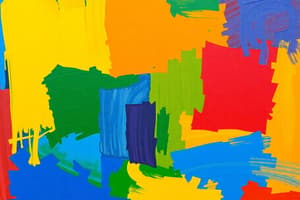Podcast
Questions and Answers
Oranges are one of the most popular vegetables.
Oranges are one of the most popular vegetables.
False (B)
Adding the color orange to kitchen decor can suppress hunger cravings.
Adding the color orange to kitchen decor can suppress hunger cravings.
False (B)
The color orange can offer security and strength during challenging times.
The color orange can offer security and strength during challenging times.
True (A)
Orange is considered a dark and gloomy color according to color psychology.
Orange is considered a dark and gloomy color according to color psychology.
Adding orange leaves and warm tones enhances the charm of spring.
Adding orange leaves and warm tones enhances the charm of spring.
The color orange can evoke both physical and mental responses.
The color orange can evoke both physical and mental responses.
Orange is often associated with sadness and despair.
Orange is often associated with sadness and despair.
The color orange is considered a youthful and energetic color.
The color orange is considered a youthful and energetic color.
Orange is commonly associated with indoor elements.
Orange is commonly associated with indoor elements.
The deeper the shade of orange, the less intense the setting is.
The deeper the shade of orange, the less intense the setting is.
A blazing sun is thought to emit blue flames instead of orange.
A blazing sun is thought to emit blue flames instead of orange.
The color orange is known for curbing hunger when it is near.
The color orange is known for curbing hunger when it is near.
Yellow is recognized as a cheerful and lively hue.
Yellow is recognized as a cheerful and lively hue.
Advertisers often use yellow lettering due to its eye-catching nature.
Advertisers often use yellow lettering due to its eye-catching nature.
Yellow stimulates the right side of the brain, promoting creative thinking.
Yellow stimulates the right side of the brain, promoting creative thinking.
The color yellow reminds us to remain impractical and dreamy.
The color yellow reminds us to remain impractical and dreamy.
Yellow is known to boost self-assurance and optimism.
Yellow is known to boost self-assurance and optimism.
Toys are often predominately red in color due to their appeal to children.
Toys are often predominately red in color due to their appeal to children.
Turquoise is known for being a stressful and fatiguing color.
Turquoise is known for being a stressful and fatiguing color.
The color turquoise promotes disorganization and chaos.
The color turquoise promotes disorganization and chaos.
Turquoise helps in calming the nervous system.
Turquoise helps in calming the nervous system.
Seeing the color turquoise can make public speakers feel more anxious.
Seeing the color turquoise can make public speakers feel more anxious.
The color turquoise has the ability to connect with our souls and offer spiritual guidance.
The color turquoise has the ability to connect with our souls and offer spiritual guidance.
Turquoise is not ideal to have around during emergencies.
Turquoise is not ideal to have around during emergencies.
Black is the ultimate lightest color.
Black is the ultimate lightest color.
If a group of teenagers is wearing black clothes, they are likely in a cheerful phase.
If a group of teenagers is wearing black clothes, they are likely in a cheerful phase.
The color black provides a feeling of emptiness.
The color black provides a feeling of emptiness.
To be 'in the black' means to owe money.
To be 'in the black' means to owe money.
The color black is widely understood according to the text.
The color black is widely understood according to the text.
Black mood refers to being in a happy mood.
Black mood refers to being in a happy mood.
Flashcards are hidden until you start studying
Study Notes
The Color Orange
- Embodies love, kindness, and familiarity, but can also evoke feelings of despair and melancholy
- Associated with enthusiasm, emotion, warmth, and joy, providing emotional strength and encouraging social communication and creativity
- Often depicted in outdoor elements, such as tropical surroundings, fire, and sun, radiating a calm yet lively essence
Characteristics of Orange
- A harmonious blend of red and yellow hues, bursting with energy and warmth
- Can trigger food cravings, especially healthy foods like oranges
- Often used in kitchen decor to stimulate appetite
- Beloved for its subtle yet unique beauty in seasonal scenes, particularly in fall
Emotional Significance of Orange
- Offers security and strength in difficult times, inspiring emotional endurance and deeper intuition
- Uplifts otherwise fallen spirits, igniting motivation, hope, and positivity
The Color Yellow
- Stimulates logical thinking, promoting practicality and encouraging curiosity and novel ideas
- Bolsters self-assurance, turning frowns upside down, and keeping us grounded
- Not often used by advertisers due to its off-putting and hard-to-discern nature
The Color Turquoise
- Combats stress and fatigue, fostering clear thinking and promoting structure
- Calms the nervous system, boosting self-assurance and facilitating emotional balance
- Connects with our souls, guiding us toward spiritual growth and harmony with our intuition
The Color Black
- Represents strength, elegance, and classics, often associated with rebelliousness in teenagers
- Provides a restful feeling of emptiness, opening the door to mystery and the unknown
- Can evoke dark and depressing thoughts, but means no harm, often misunderstood
Studying That Suits You
Use AI to generate personalized quizzes and flashcards to suit your learning preferences.



